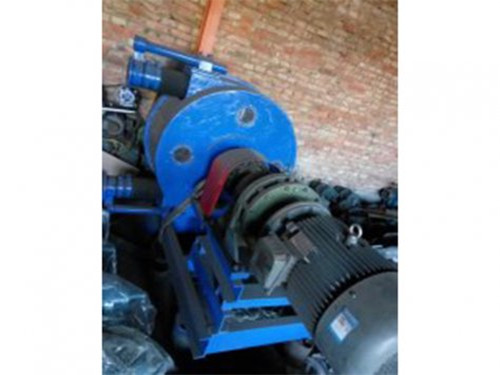Gear oil pump series
High viscosity pump series
Centrifugal pump series
Pump series for other purposes

Industrial hose pump
The advantages of industrial hose pumps: unique unsealed structure, no leakage or pollution; The rolling technology adopted does not require any lubrication for the pressure roller; Self suction and self-cleaning ability, capable of positive and negative suction of materials; Simple hose device, easy installation and maintenance, low maintenance cost, and simple operation; The flow rate can be linearly adjusted and has metering functions; There is no blockage in the transportation of fluids with high viscosity and impurities; The lifespan of the pump
Long, high head, and high pump outlet pressure
Working principle
A smooth and strong rubber hose is installed inside the pump. It is rotated and compressed along the hose by a pair of pressure rollers. This rotation allows the medium to be transported in one direction without backflow. After conveying the medium, the hose is restored to its original state by the elasticity of the flattened hose and the force of the side guide roller. At this time, a high vacuum is generated inside the hose to suck the medium back into the pipe cavity.
; Then the medium is discharged from the hose under the pressure of the accompanying pressure roller. Starting from this cycle, the medium is constantly being sucked in and dischargedThe strong comparison between industrial hose pumps and other volumetric pumps in terms of usage and maintenance when handling abrasive media shows that industrial hose pumps have lower full life cycle costs. Industrial hose pump manufacturers may be more expensive than other volumetric pumps, but they have an overwhelming advantage in terms of subsequent maintenance, downtime, downtime, and the cost of purchasing ancillary equipment
Why industrial hose pumps do not require auxiliary equipment
Another advantage of industrial hose pumps is auxiliary equipment.
. Sometimes, centrifugal mud pumps require storage tanks and mixers; However, screw pumps sometimes require a dry run protector and a sealed flushing system, which increases the consumption of flushing water and electricity; The diaphragm pump needs to install a check valve to prevent siphoning. Auxiliary equipment hose pumps sometimes require an inexpensive pulsation buffer to pulsation, but in general, changing the pipe diameter or externally connecting a one meter flexible pipe can also solve the problemAs the core of the hose pump, the pump tube is fixed in the pump chamber and compressed by an external pressure roller to push the medium out towards the outlet; The compressed hose immediately returns to a circular shape, generating a vacuum and sucking more medium into the inner chamber of the hose, thus completing the transportation process in a repetitive manner. The medium is contained in the inner chamber of the hose, and other moving parts such as the pressure roller will not come into contact with it. Therefore, the hose pump is a type of pump without valves or moving parts that come into contact with the mediumIndustrial hose pumps have almost volumetric efficiency, and the flow rate only depends on the speed and is independent of the outlet pressure; Its characteristics of resistance to idling without damage are suitable for conveying gas liquid, foam liquid, gas solid liquid three-phase mixed media without cavitation and gas resistance; It can generate almost full vacuum for liquid suction - with a suction head of up to eight meters or more of water column; In addition, the hose pump can also reverse flush the sediment and blockages in the pipeline, and has self-cleaning ability; The hose pump operates very gently and is suitable for conveying shear sensitive media. The closure of the soft tube cavity prevents backflow and activates the check valve
Industrial hose pump applications:
1. Chemical industry: acid, alkali, phosphate slurry, and inorganic salt materials such as titanium dioxide;
2. Petrochemical industry: drilling mud and original transportation3. Water treatment: transportation of sludge, lime slurry, etc4. Mining and metallurgical industries: transportation of filling materials in gold mining and slurry in gold smelting processes5. Pharmaceutical industry: transportation of various pharmaceutical materials and liquids6. Food industry: transportation of oil materials and beverages7. Paper industry: pulp and sulfur slurry transportation8. Construction industry: cement mortar conveying9. Ceramic industry: conveying ceramic glaze slurry and other materials10. Transportation of liquids with high sealing requirements, high viscosity, and high particle content, such as nuclear waste, electrolytic waste, metal slag liquid, paint, coating, adhesive, glue, latex, refractory fiber slurry, and other liquids
| Model | Power KW | Flow rate m ³/ H | Pressure MPa | Speed r/min |
| IHP20 | 0.75 | 0.3 | 1 | 42 |
| IHP25 | 1.1 | 0.5 | 1 | 34 |
| IHP32 | 1.5 | 1 | 1 | 42 |
| IHP40 | 1.5/2.2 | 1.5-2.5 | 1 | 34-50 |
| IHP50 | 2.2/4 | 3-6 | 1 | 25-50 |
| IHP65 | 4/7.5 | 7-11 | 1 | 25-42 |
| IHP65D | 7.5/11 | 18-25 | 0.8 | 34-50 |
| IHP75 | 5.5/7.5 | 15-20 | 0.8 | 42-50 |
| IHP75D | 11/15 | 30-35 | 0.8 | 42-50 |
Selection and Application of Gear Pump Seals
Why is it necessary to seal a gear pump ? The sealing of a gear pump primarily occurs in tw ...
2025-09-24
Maintenance precautions for gear pumps transporting heavy oil
For the maintenance of gear pumps transporting heavy oil (such as fuel oil, residual oil, a ...
2025-09-17
Application scope and occasions of electric gear pump
Electric gear pump , as the name suggests, is a gear pump driven by an electric motor. It i ...
2025-09-10
Introduction to the advantages and disadvantages of gear pumps with electric heating tubes and asphal
Gear pumps with electric heating tubes and asphalt pumps with insulation layers are commonl ...
2025-09-03



